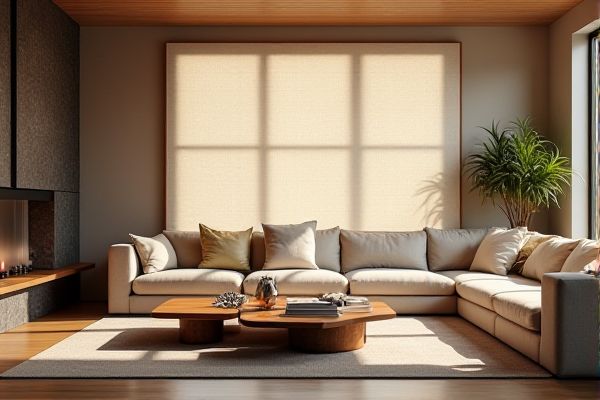
Living screens feature dynamic, adaptable displays that enhance user interaction through advanced technology, while panel screens offer static, fixed visuals commonly used for standard presentations. Discover how understanding the differences between living screens and panel screens can elevate your display experience by exploring the rest of this article.
Table of Comparison
| Feature | Living Screen | Panel Screen |
|---|---|---|
| Definition | Interactive, immersive display integrating sensors and real-time data. | Static or dynamic display primarily focused on visual content presentation. |
| Interactivity | High - supports touch, gesture, and sensor inputs. | Low to medium - mostly touch or remote controlled. |
| Use Cases | Smart homes, digital signage, interactive advertising. | TVs, computer monitors, traditional advertising panels. |
| Technology | Integrates IoT sensors, AI for adaptive display. | Uses LED, LCD, OLED display technologies. |
| Content Adaptation | Dynamically changes based on user interaction and environment. | Pre-set content or scheduled display. |
| Cost | Higher due to advanced sensors and AI integration. | Generally lower, standardized production. |
| Maintenance | Complex, requires updates and sensor calibration. | Simple, mostly hardware-focused maintenance. |
Introduction to Living Screens vs Panel Screens
Living screens use micro-LED technology to deliver superior brightness, color accuracy, and energy efficiency compared to traditional panel screens, which typically rely on LCD or OLED displays. Panel screens often suffer from limited viewing angles and lower contrast ratios, while living screens provide vibrant visuals and seamless scalability for large-format displays. Your choice between living screens and panel screens depends on the need for advanced image quality and durability in high-usage environments.
Defining Living Screens: Concepts and Benefits
Living screens integrate natural elements like plants and water features with digital displays, creating immersive environments that enhance aesthetics and air quality. These innovative solutions boost mental well-being and productivity by merging biophilic design with advanced technology. Your space becomes a dynamic, health-promoting environment that fosters creativity and relaxation through the synergy of living materials and interactive screens.
What Are Panel Screens? Overview and Applications
Panel screens, also known as flat-panel displays, encompass technologies like LCD, LED, OLED, and plasma screens, characterized by their thin, lightweight structure for versatile applications. Commonly used in smartphones, TVs, monitors, and digital signage, panel screens deliver high-resolution images with vibrant colors and energy efficiency. Their compact form factor enables integration into various devices, enhancing user experience across consumer electronics, medical imaging, and industrial automation.
Aesthetic Differences: Living Screens vs Panel Screens
Living screens showcase dynamic, lifelike visuals with vibrant colors and smooth motion, offering an immersive aesthetic experience ideal for digital art and advertisements. Panel screens typically present static or less dynamic images with uniform brightness and color consistency, emphasizing clarity and sharpness suitable for information display. The organic appeal of living screens contrasts with the structured, minimalistic design of panel screens, making each suitable for different aesthetic preferences and environments.
Environmental Impact and Sustainability
Living screens, incorporating natural plants, enhance air quality by absorbing CO2 and producing oxygen, contributing positively to indoor environmental health. Panel screens, primarily made from synthetic materials, often involve higher energy consumption and waste during production and disposal, posing greater environmental challenges. Choosing living screens supports sustainability efforts by reducing your carbon footprint and promoting a greener indoor environment.
Privacy and Space Division: Functional Comparisons
Living screens offer adaptable privacy solutions by creating flexible partitions that can be easily moved or adjusted, maximizing space division in open areas. Panel screens provide more permanent separation, ideal for defined privacy zones but less versatile in rearranging room layout. Your choice depends on whether you prioritize mobility and space fluidity or fixed privacy boundaries.
Maintenance Requirements for Living and Panel Screens
Living screens require regular watering, trimming, and pest control to maintain their health and visual appeal, making them more labor-intensive than panel screens. Panel screens typically need minimal upkeep, usually limited to occasional cleaning and inspections for physical damage or wear. Your choice depends on whether you prioritize natural aesthetics with ongoing care or low-maintenance durability.
Cost Analysis: Installation and Long-term Investment
Living screens typically involve higher upfront installation costs due to the need for specialized mounting and integration with living spaces, but their long-term investment can be justified by enhanced durability and energy efficiency. Panel screens, while generally more affordable to install, may incur additional maintenance or replacement expenses over time due to their standard construction and shorter lifespan. Evaluating Your budget for initial installation against projected long-term savings is crucial for making a cost-effective decision between living screens and panel screens.
Best Use Cases for Living Screens vs Panel Screens
Living screens excel in dynamic environments like retail displays and event stages, providing vibrant visuals and flexible size options for immersive viewer engagement. Panel screens, with their high resolution and energy efficiency, are ideal for corporate presentations, digital signage, and home entertainment systems where consistent image quality and durability are paramount. Choosing living screens suits scenarios demanding adaptability and striking aesthetics, while panel screens better serve applications requiring long-term reliability and precise image clarity.
Choosing the Right Screen for Your Space
When selecting between a living screen and a panel screen, consider factors like space size, privacy needs, and aesthetic preferences. Living screens, often made of natural materials with plants, enhance air quality and bring a calming green element ideal for larger or open-plan areas. Panel screens offer versatile design options and compact form, suitable for smaller spaces requiring flexible partitioning or a clean, modern look.
 homyna.com
homyna.com